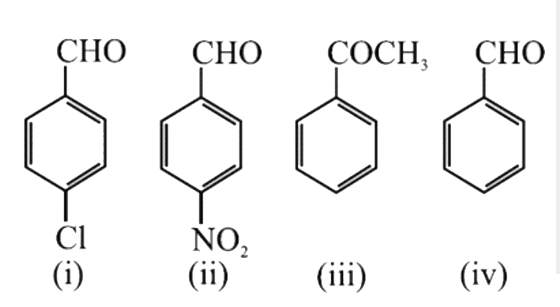Arrange these compounds in decreasing order of reactivity for the nucleophilic addition reaction:
(l) Acid chloride
(ll) Aldehyde
(lll) Ketone
(lV) Ester
Select the correct answer from the codes given below:
l > ll > lll > lV
IV> III > II > I
III > II > I > IV
I > IV >II >III
The correct Answer is:A
To arrange the compounds in decreasing order of reactivity for nucleophilic addition reactions, we need to analyze the electron deficiency of the carbonyl carbon in each compound. The more electron-deficient the carbonyl carbon is, the more reactive it will be towards nucleophiles.
1. Identify the Compounds: The compounds given are:
- (I) Acid chloride (RCOCl)
- (II) Aldehyde (RCHO)
- (III) Ketone (RCOR')
- (IV) Ester (RCOOR')
2. Understand the Effects on Electrophilicity:
- Acid Chloride: The carbonyl carbon is highly electrophilic due to the strong electron-withdrawing effect of the chlorine atom. This makes acid chlorides very reactive.
- Aldehyde: Aldehydes have one electron-donating group (alkyl or hydrogen) and one electron-withdrawing carbonyl group. This results in a moderate level of electrophilicity.
- Ketone: Ketones have two electron-donating groups (alkyl groups), which reduce the electrophilicity of the carbonyl carbon compared to aldehydes.
- Ester: Esters have an alkoxy group (OR) that can donate electrons through resonance, further reducing the electrophilicity of the carbonyl carbon.
3. Rank the Compounds:
- Most Reactive: Acid Chloride (I) - highest electrophilicity due to strong electron-withdrawing effect of Cl.
- Second Reactive: Aldehyde (II) - moderate electrophilicity due to one electron-donating group.
- Third Reactive: Ketone (III) - lower electrophilicity due to two electron-donating groups.
- Least Reactive: Ester (IV) - lowest electrophilicity due to resonance donation from the alkoxy group.
4. Final Order: Based on the analysis, the order of reactivity for nucleophilic addition reactions is:
- (I) Acid chloride > (II) Aldehyde > (III) Ketone > (IV) Ester
Conclusion:
The correct order of reactivity for the nucleophilic addition reaction is:
(I) > (II) > (III) > (IV)
- (I) Acid chloride (RCOCl)
- (II) Aldehyde (RCHO)
- (III) Ketone (RCOR')
- (IV) Ester (RCOOR')
- Acid Chloride: The carbonyl carbon is highly electrophilic due to the strong electron-withdrawing effect of the chlorine atom. This makes acid chlorides very reactive.
- Aldehyde: Aldehydes have one electron-donating group (alkyl or hydrogen) and one electron-withdrawing carbonyl group. This results in a moderate level of electrophilicity.
- Ketone: Ketones have two electron-donating groups (alkyl groups), which reduce the electrophilicity of the carbonyl carbon compared to aldehydes.
- Ester: Esters have an alkoxy group (OR) that can donate electrons through resonance, further reducing the electrophilicity of the carbonyl carbon.
- Most Reactive: Acid Chloride (I) - highest electrophilicity due to strong electron-withdrawing effect of Cl.
- Second Reactive: Aldehyde (II) - moderate electrophilicity due to one electron-donating group.
- Third Reactive: Ketone (III) - lower electrophilicity due to two electron-donating groups.
- Least Reactive: Ester (IV) - lowest electrophilicity due to resonance donation from the alkoxy group.
- (I) Acid chloride > (II) Aldehyde > (III) Ketone > (IV) Ester
The correct order of reactivity for the nucleophilic addition reaction is:
(I) > (II) > (III) > (IV)
Topper's Solved these Questions
- CARBONL COMPOUNDSBOOK - MOTIONCHAPTER - CARBONL COMPOUNDSEXERCISE - EXERCISE -2 (LEVEL-II)
18 Videos
- CARBONL COMPOUNDSBOOK - MOTIONCHAPTER - CARBONL COMPOUNDSEXERCISE - EXERCISE - 3
10 Videos
- CARBONL COMPOUNDSBOOK - MOTIONCHAPTER - CARBONL COMPOUNDSEXERCISE - EXERCISE -1
40 Videos
- BIOMOLECULES & POLYMERSBOOK - MOTIONCHAPTER - BIOMOLECULES & POLYMERSEXERCISE - EXERCISE - 4 (LEVEL II)
17 Videos
- CARBOXYLIC ACIDBOOK - MOTIONCHAPTER - CARBOXYLIC ACIDEXERCISE - Exercise - 4 (LEVEL - 2 )
22 Videos
Similar Questions
Knowledge Check
Match the following and select the correct answer from the codes given below:
 AABCD1342BABCD2134CABCD2143DABCD1324
AABCD1342BABCD2134CABCD2143DABCD1324Arrange the following compounds in decreasing order of nucleophilic addition reaction :
 AII>IV>III>IBI>II>III>IVCIV>III>II>IDII>III>IV>I
AII>IV>III>IBI>II>III>IVCIV>III>II>IDII>III>IV>IMatch the following and select the correct answer from the codes given below.
 A(i) - (q), (ii) - (p), (iii) - (r )B(i) - (p) , (ii) - (r ), (iii) - (q)C(i) - (r ) , (ii) - (p) , (iii) - (q)D(i) - (q), (ii) - (r ) , (iii) - (p)
A(i) - (q), (ii) - (p), (iii) - (r )B(i) - (p) , (ii) - (r ), (iii) - (q)C(i) - (r ) , (ii) - (p) , (iii) - (q)D(i) - (q), (ii) - (r ) , (iii) - (p)
Arrange the following carbonyl compounds in increasing order of their reactivity in nucleophilic addition reaction.
View SolutionArrange in following carbonyl compounds in decreasing order of their reactivity in nucleophilic addition reaciton .

View SolutionArrange the followings accroding to the increasing order of reactivity in nucleophilic addition reaction
I(Acetaldehyde ) II(Acid chloride) III( Ketone) IV (Easter)
View SolutionArrange the following compounds in decreasing order of reactivity towards nucleophilic addition reaction.
Diethylketone (I) Benzaldehyde (II) Propanal (III) Acetaldehyde (IV)
View SolutionMatch list I with list II and then select the correct answer from the codes given below

Codes :
View Solution


